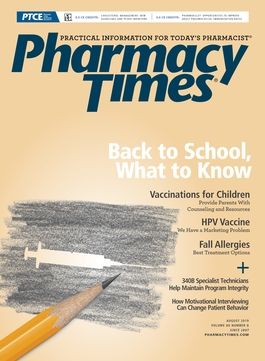Publication
Article
Pharmacy Times
Is It Tonsillitis or Influenza?
Author(s):
During flu season, a sore throat can signal another illness—Here is how to tell the difference.
Distinguishing between respiratory infections with clinical presentation similarities can be a challenge for providers.
Tonsillitis and influenza infections are common reasons patients seek care, especially during peak season (November to April).1,2 Influenza is a well-known and well-documented viral infection that causes widespread outbreaks.3 Three subtypes of the influenza virus exist: A, B, and C,2-6 with type A possessing the greatest virulence.2 In an influenza season, prevalence estimates are 20% to 30% in children and less than half of that in adults, at 5% to 10% worldwide. Three million to 5 million influenza cases are considered severe, and the infection claims an estimated 250,000 to 500,000 lives each year.3 Although these statistics can be startling, influenza death and illness rates vary greatly from year to year, subject to the virulence of the present strains and the associated population immunity to these strains.7
Acute tonsillitis is an infection and inflammation of the tonsils. Tonsillitis is often included in pharyngitis statistics, as the average person may have 2 to 6 sore throats annually.6 Causes of tonsillitis are idiopathic (30%-65%), viral (30%-60%), and bacterial (5%-10%).8 Clinicians need to consider group A streptococcus infection (GAS) as a reason for tonsillitis. Of patients with tonsillitis, 5% to 10% of adults and 20% to 30% of pediatric patients have GAS.1,9
Tonsillitis and influenza share several risk factors, including age, dry air, environmental allergies, smoking, upper respiratory infection symptoms, and time of year, according to the CDC. More risks specific to tonsillitis are exposure to secondhand smoke or pollution and a history of acid reflux disease.7
TRANSMISSION AND SYMPTOMS
Both illnesses are usually transmitted from person to person in one of 2 ways: through airborne droplets spread from secretions generated by coughing, sneezing, or talking and indirectly via fomites, such as cups, doorknobs, tissues, and utensils. Incubation lasts between 1 and 4 days. Influenza is generally most infectious for 24 to 48 hours, whereas tonsillitis can be contagious for 7 to 10 days.2
Many influenza cases present with symptoms of other common respiratory infections, including abrupt onset of fever (greater than 101°F), chills, cough, headache, and myalgia.2,7,10 Sinus problems and sore throat may also be present. Children are likely to have gastrointestinal symptoms of abdominal pain, diarrhea, and vomiting.2
Tonsillitis also has several general symptoms, including chills, fever, painful swallowing, sore throat, swollen tonsils, and tonsillar exudate.5,6 Major criteria that must be present for tonsillitis comprise sore throat in conjunction with erythema and/or tonsillar exudate, which may or may not be accompanied by a scarlatiniform rash. Minor criteria are fever and malaise.9 The aforementioned criteria, with the addition of cervical adenopathy, palatal petechiae, and vomiting, increase the likelihood of developing GAS to more than 50%.5,8 Symptoms that may signal a more serious condition include drooling, limited neck movement or stiffness, respiratory distress, and toxic appearance.
Given the similar clinical pictures, risk factors, and transmission, providers must ponder the differentials. The Centor criteria can be helpful for distinguishing viral infections.8 Clinicians should consider anaphylaxis, angioedema, croup, epiglottis, foreign body ingestion, lateral/retropharyngeal abscess, mononucleosis infection, otitis media, peritonsillar abscess, pharyngitis, and pneumonia.2,4,5,7,10
Several laboratory methods exist to diagnosis influenza and tonsillitis. Practitioners can perform all influenza tests via a nasopharyngeal swab or wash from the patient. The gold standard is the viral culture, though results take at least 48 hours, and it is used more for research purposes.2,3 Practitioners most commonly use rapid antigen testing, or point-of-care testing, though sensitivity is estimated at 40% to 80%,3,11 so a negative test does not eliminate the possibility of influenza.3 The same type of testing has a lower sensitivity in bacterial tonsillitis diagnosis than the throat culture, a more accurate test, which takes longer to show results.4,8,9 The throat culture helps rule in GAS and identifies >90% of cases.8 Except in the case of GAS-associated tonsillitis, practitioners rarely culture bacteria from patients with tonsillitis.4 A complete blood count and C-reactive protein are sometimes suggested but are not significant parameters.8
Most cases of both influenza and tonsillitis are self-limiting and viral. Clinicians can treat these cases with OTC medications, such as nonsteroidal anti-inflammatory drugs and Tylenol, or topical therapies, such as oral rinses, sprays, and lozenges. Numerous episodes of tonsillitis in an illness season may require a tonsillectomy,4 whereas multiple episodes of influenza are uncommon.
Patients may require prescription treatment for more severe illness, such as GAS tonsillitis and severe influenza. Antibiotics are necessary for GAS tonsillitis (amoxicillin, penicillin V potassium, or single-dose intramuscular penicillin G). For patients who are allergic to penicillin, clinicians should use clindamycin or macrolides. Fluoroquinolones, sulfonamides, and tetracyclines are not indicated for GAS.5,6,9 However, antibiotics are still prescribed unnecessarily for tonsillitis and influenza at high rates.6,7,9
Two medication classes, adamantanes and neuraminidase inhibitors (NIs), are approved to treat influenza.2 However, practitioners use NIs more frequently because amantadines have greater resistance, though NI resistance is also growing.2,3 These medications generally decrease symptom severity, lower complication/hospitalization risk, and reduce illness by 24 hours.7 Importantly, providers should educate patients about the adverse effects of any prescriptions as well.
Complications are uncommon. Occasionally, GAS tonsillitis causes acute glomerulonephritis and/or rheumatic fever without appropriate antibiotic treatment.4,8 Influenza can cause organ shutdown and death, though these are rare.7
Jenna Herman, DNP, APRN, FNP-BC, is the family nurse practitioner program coordinator and an assistant professor at the University of Mary in Bismarck, North Dakota. Her clinical practice includes the emergency department of a level II trauma center, correctional medicine, and locum tenens in primary care clinics, nursing homes, and hospitals across rural North Dakota.
REFERENCES
- Sore throat. CDC website. cdc.gov/antibiotic-use/community/for-patients/ common-illnesses/sore-throat.html. Updated April 17, 2015. Accessed June 16, 2019.
- Sivasankar S, Wang E. Diagnosis and management of influenza. Primary Care Rep. 2015;21(6):65-71.
- Abraham MK, Perkins J, Vilke GM, Coyne CJ. Influenza in the emergency department: vaccination, diagnosis, and treatment: clinical practice paper approved by American Academy of Emergency Medicine clinical guidelines committee. J Emerg Med. 2016;50(3):536-542. doi: 10.1016/j.jemermed.2015.10.013.
- Georgalas CC, Tolley NS, Narula A. Tonsillitis. BMJ Clin Evid. 2014;2014:pii:0503.
- 5. Bochner RE, Gangar M, Belamarich PF. A clinical approach to tonsillitis, ton- sillar, hypertrophy, and peritonsillar and retropharyngeal abscess. Pediatr Rev. 2017;38(2):81-92. doi: 10.1542/pir.2016-0072.
- Suzumoto M, Hotomi M, Billal DS, Fujihara K, Harabuchi Y, Yamanaka N. A scoring system for management of acute pharyngo-tonsillitis in adults. Auris Nasus Larynx. 2009;36(3):314-320. doi: 10.1016/j.anl.2008.07.001.
- Hart AM. Influenza: a clinical update following a century of influenza science. J Nurse Pract. 2016;15(6):429-433. doi: 10.1016/j.nurpra.2018.12.026.
- Furuncuoglu Y, Saglam F, Kutluhan A. Acute exudative tonsillitis in adults: the use of the Centor score and some laboratory tests. Turk J Med Sci. 2016;46(6):1755-1759. doi: 10.3906/sag-1510-93.
- Di Muzio F, Barucco M, Guerriero F. Diagnosis and treatment of acute pharyngitis/ tonsillitis: a preliminary observational study in general medicine. Eur Rev for Med Pharmacol Sci. 2016;20(23):4950-4954.
- Krein PM. Clinical diagnosis of influenza-like illness: the flu and beyond. MLO Med Lab Obs. 2012;44(11):32,34.
- Li-Kim-Moy J, Dastouri F, Rashid H, et al. Utility of early influenza diagnosis through point-of-care testing in children presenting to an emergency department. J Paediatr Child Health. 2016;52(4):422-429. doi: 10.1111/jpc.13092.







